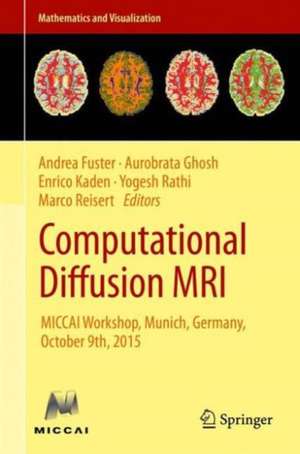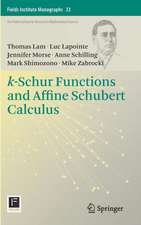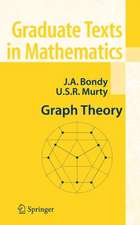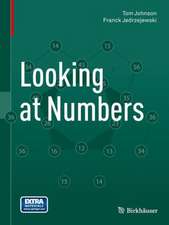Computational Diffusion MRI: MICCAI Workshop, Munich, Germany, October 9th, 2015: Mathematics and Visualization
Editat de Andrea Fuster, Aurobrata Ghosh, Enrico Kaden, Yogesh Rathi, Marco Reiserten Limba Engleză Hardback – 9 apr 2016
Over thelast decade interest in diffusion MRI has exploded. The technique providesunique insights into the microstructure of living tissue and enables in-vivoconnectivity mapping of the brain. Computational techniques are key to thecontinued success and development of diffusion MRI and to its widespreadtransfer into clinical practice. New processing methods are essential for addressingissues at each stage of the diffusion MRI pipeline: acquisition, reconstruction,modeling and model fitting, image processing, fiber tracking, connectivitymapping, visualization, group studies and inference.
Thisvolume, which includes both careful mathematical derivations and a wealth ofrich, full-color visualizations and biologically or clinically relevantresults, offers a valuable starting point for anyone interested in learningabout computational diffusion MRI and mathematical methods for mapping brainconnectivity, as well as new perspectives and insights on current researchchallenges for those currently working in the field. It will be of interest toresearchers and practitioners in the fields of computer science, MR physics,and applied mathematics.
| Toate formatele și edițiile | Preț | Express |
|---|---|---|
| Paperback (2) | 590.12 lei 38-44 zile | |
| Springer International Publishing – 25 apr 2018 | 590.12 lei 38-44 zile | |
| Springer International Publishing – 28 iul 2018 | 636.94 lei 6-8 săpt. | |
| Hardback (2) | 592.35 lei 38-44 zile | |
| Springer International Publishing – 9 apr 2016 | 592.35 lei 38-44 zile | |
| Springer International Publishing – 13 mai 2017 | 643.16 lei 6-8 săpt. |
Din seria Mathematics and Visualization
- 20%
 Preț: 935.20 lei
Preț: 935.20 lei - 18%
 Preț: 960.93 lei
Preț: 960.93 lei - 18%
 Preț: 1110.41 lei
Preț: 1110.41 lei - 20%
 Preț: 994.26 lei
Preț: 994.26 lei - 18%
 Preț: 1220.57 lei
Preț: 1220.57 lei - 18%
 Preț: 958.38 lei
Preț: 958.38 lei - 15%
 Preț: 654.62 lei
Preț: 654.62 lei - 20%
 Preț: 997.38 lei
Preț: 997.38 lei - 15%
 Preț: 645.47 lei
Preț: 645.47 lei - 5%
 Preț: 1101.58 lei
Preț: 1101.58 lei - 20%
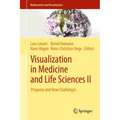 Preț: 992.44 lei
Preț: 992.44 lei - 20%
 Preț: 1284.47 lei
Preț: 1284.47 lei - 20%
 Preț: 656.69 lei
Preț: 656.69 lei - 20%
 Preț: 476.68 lei
Preț: 476.68 lei - 20%
 Preț: 1273.08 lei
Preț: 1273.08 lei - 15%
 Preț: 649.54 lei
Preț: 649.54 lei - 20%
 Preț: 335.36 lei
Preț: 335.36 lei - 20%
 Preț: 646.95 lei
Preț: 646.95 lei - 20%
 Preț: 651.75 lei
Preț: 651.75 lei - 20%
 Preț: 657.99 lei
Preț: 657.99 lei - 18%
 Preț: 1223.74 lei
Preț: 1223.74 lei - 20%
 Preț: 333.72 lei
Preț: 333.72 lei - 20%
 Preț: 709.98 lei
Preț: 709.98 lei - 18%
 Preț: 1236.38 lei
Preț: 1236.38 lei - 20%
 Preț: 992.26 lei
Preț: 992.26 lei - 20%
 Preț: 648.44 lei
Preț: 648.44 lei - 20%
 Preț: 1158.59 lei
Preț: 1158.59 lei - 20%
 Preț: 330.66 lei
Preț: 330.66 lei - 18%
 Preț: 963.91 lei
Preț: 963.91 lei - 15%
 Preț: 653.98 lei
Preț: 653.98 lei - 20%
 Preț: 991.94 lei
Preț: 991.94 lei - 18%
 Preț: 958.07 lei
Preț: 958.07 lei
Preț: 592.35 lei
Preț vechi: 740.44 lei
-20% Nou
Puncte Express: 889
Preț estimativ în valută:
113.36€ • 117.45$ • 94.61£
113.36€ • 117.45$ • 94.61£
Carte tipărită la comandă
Livrare economică 18-24 martie
Preluare comenzi: 021 569.72.76
Specificații
ISBN-13: 9783319285863
ISBN-10: 3319285866
Pagini: 164
Ilustrații: IX, 234 p. 83 illus., 63 illus. in color.
Dimensiuni: 155 x 235 mm
Ediția:1st ed. 2016
Editura: Springer International Publishing
Colecția Springer
Seria Mathematics and Visualization
Locul publicării:Cham, Switzerland
ISBN-10: 3319285866
Pagini: 164
Ilustrații: IX, 234 p. 83 illus., 63 illus. in color.
Dimensiuni: 155 x 235 mm
Ediția:1st ed. 2016
Editura: Springer International Publishing
Colecția Springer
Seria Mathematics and Visualization
Locul publicării:Cham, Switzerland
Cuprins
An Efficient FiniteElement Solution of the Generalised Bloch-Torrey Equation for ArbitraryDomains: L. Beltrachini et al.- Super-Resolution Reconstruction ofDiffusion-Weighted Images using 4D Low-Rank and Total Variation: Feng Shi etal.- Holistic Image Reconstruction for Diffusion MRI: V. Golkov et al.- Alzheimer’sDisease Classification with Novel Microstructural Metrics fromDiffusion-Weighted MRI: T. M. Nir et al.- Brain Tissue Micro-Structure Imagingfrom Diffusion MRI Using Least Squares Variable Separation: H. Farooq et al.-Multi-Tensor MAPMRI: How to Estimate Microstructural Information from CrossingFibers: M. Zucchelli et al.- On the Use of Antipodal Optimal DimensionalitySampling Scheme on the Sphere for Recovering Intra-Voxel Fibre Structure inDiffusion MRI: A.P. Bates et al.- Estimation of Fiber Orientations UsingNeighborhood Information: C. Ye et al.- A framework for creating populationspecific multimodal brain atlas using clinical T1 and diffusion tensor images:V. Gupta et al.- Alignment of Tractograms as Linear Assignment Problem: N. Sharmin.-Accelerating Global Tractography Using Parallel Markov Chain Monte Carlo: H. Wuet al.- Adaptive Enhancement in Diffusion MRI Through Propagator Sharpening: T.Dela Haije et al.- Angular Resolution Enhancement of Diffusion MRI Data UsingInter-Image Information Transfer: Geng Chen et al.- Crossing versus Fanning:Model Comparison Using HCP Data: A. Ghosh et al.- White Matter Fiber SetSimplification by Redundancy Reduction with Minimum Anatomical InformationLoss: G. Zimmerman Moreno et al.- A Temperature Phantom to Probe the EnsembleAverage Propagator Asymmetry: an In-Silico Study: M. Pizzolato et al.-Registration Strategies for Whole-Body Diffusion-Weighted MRI Stitching: J.Ceranka et al.- HARDI Feature Selection, Registration and Atlas Building forA$\beta$ Pathology Classification: E. Schwab et al.- Reliability of StructuralConnectivity Examined with Four Different Diffusion Reconstruction Methods atTwo Different Spatial and Angular Resolutions: J. E. Villalon-Reina et al.
Textul de pe ultima copertă
These Proceedings of the 2015 MICCAI Workshop “Computational Diffusion MRI” offer a snapshot of the current state of the art on a broad range of topics within the highly active and growing field of diffusion MRI. The topics vary from fundamental theoretical work on mathematical modeling, to the development and evaluation of robust algorithms, new computational methods applied to diffusion magnetic resonance imaging data, and applications in neuroscientific studies and clinical practice.
Over the last decade interest in diffusion MRI has exploded. The technique provides unique insights into the microstructure of living tissue and enables in-vivo connectivity mapping of the brain. Computational techniques are key to the continued success and development of diffusion MRI and to its widespread transfer into clinical practice. New processing methods are essential for addressing issues at each stage of the diffusion MRI pipeline: acquisition, reconstruction, modeling and model fitting,image processing, fiber tracking, connectivity mapping, visualization, group studies and inference.
This volume, which includes both careful mathematical derivations and a wealth of rich, full-color visualizations and biologically or clinically relevant results, offers a valuable starting point for anyone interested in learning about computational diffusion MRI and mathematical methods for mapping brain connectivity, as well as new perspectives and insights on current research challenges for those currently working in the field. It will be of interest to researchers and practitioners in the fields of computer science, MR physics, and applied mathematics.
Over the last decade interest in diffusion MRI has exploded. The technique provides unique insights into the microstructure of living tissue and enables in-vivo connectivity mapping of the brain. Computational techniques are key to the continued success and development of diffusion MRI and to its widespread transfer into clinical practice. New processing methods are essential for addressing issues at each stage of the diffusion MRI pipeline: acquisition, reconstruction, modeling and model fitting,image processing, fiber tracking, connectivity mapping, visualization, group studies and inference.
This volume, which includes both careful mathematical derivations and a wealth of rich, full-color visualizations and biologically or clinically relevant results, offers a valuable starting point for anyone interested in learning about computational diffusion MRI and mathematical methods for mapping brain connectivity, as well as new perspectives and insights on current research challenges for those currently working in the field. It will be of interest to researchers and practitioners in the fields of computer science, MR physics, and applied mathematics.
Caracteristici
Includes supplementary material: sn.pub/extras
